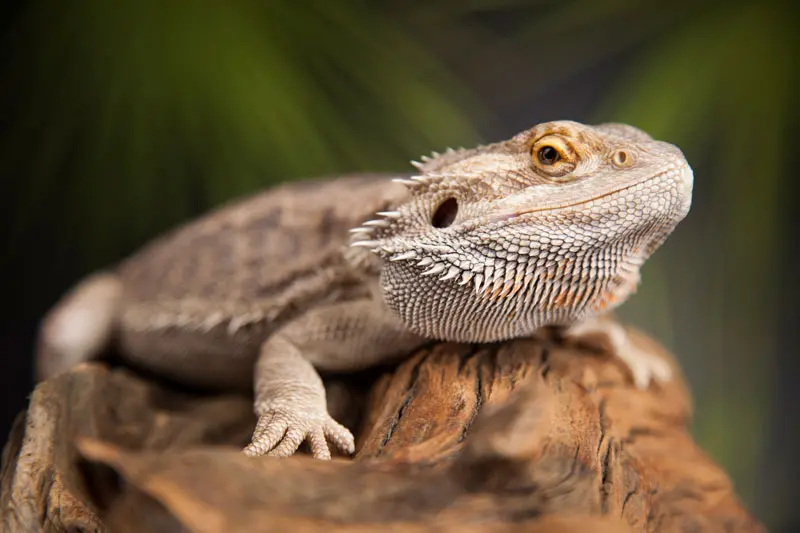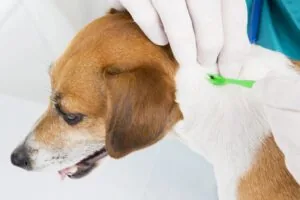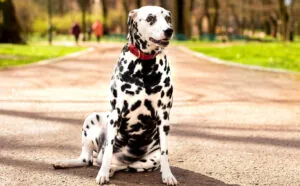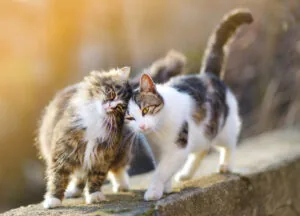Exotic Pet Spotlight: Caring for Bearded Dragons

The bearded dragon (also known as the dragon) is found naturally in Australia, but bearded dragons are kept as exotic pets in many places all around the world. Bearded dragons are commonly available at stores, reptile expos and breeders’ websites. Captive-bred specimens are highly recommended because they are usually healthier and more acclimated to captivity than wild-caught animals. Various color morphs are available, too (though they’re more costly than “normal-colored” animals). The bearded dragon is known for being alert, hardy and tame, and bearded dragon owners love watching their lizards, whether during a feeding frenzy while chasing crickets or simply interacting with each other.
Size
Hatchlings measure about 4 inches; and can grow up to 24 inches long but that is including their long tail, making the bearded dragon fairly small in body size for a lizard.
Lifespan
Average captive lifespan is between six and 10 years, but with excellent care, some have lived to be more than 14 years old.
Caging Tips
While a hatchling dragon could live in a 20-gallon aquarium for a short time, it will quickly need a larger enclosure. A 75-gallon aquarium or equal-sized enclosure is OK for one or two adult dragons. Screening should be used for proper ventilation, whether as a top on an aquarium enclosure or in the construction of a custom enclosure. During warm weather bearded dragons can be kept in outdoor cages. Be sure the outdoor enclosure provides both sunny basking areas and shady retreats, as well as shelter from rain. Having access to the sun outdoors provides healthy UV rays. Bearded dragons like to climb, so some sturdy branches are welcome in their enclosures.
Lighting and Temperature
Bearded dragons are cold-blooded (ectotherms), meaning they maintain their body temperature based on the environmental temperature. If it is cold in the room, they are cold. If it is warm in their environment, they are warm. Because of this, they often like to bask in the sunlight.
A basking site of about 100 degrees Fahrenheit works well for them. The basking site can be provided by a spotlight (such as a mercury vapor bulb) positioned over a rock, branch, etc. at one end of the enclosure. Keeping the spotlight at one end of the cage will allow your dragon to thermoregulate (move between a cooler end of the enclosure and the hotter end with the basking area). The cooler end of the enclosure can be kept at about 80 degrees.
In addition to the basking spotlight, provide full-spectrum UVB (ultraviolet) lighting over the rest of the enclosure. This lighting is critically important for dragons that are kept indoors, as it assists them in synthesizing vitamin D3, which aids in calcium absorption. There are many types of lights available; consult with store employees and read the packaging to determine the best for your setup. Heat can also be provided using heat tape, heat emitters and other devices available in pet stores. Keep a thermometer in the enclosure to track the cage temperature. At night, it can go down to about 65 degrees.
Substrate
Sand is commonly used with bearded dragons, though there is concern, especially when keeping young lizards, that intestinal impaction could result if they accidentally eat some. It is not recommended that you keep young bearded dragons on sand, or any kind of loose substrate. Newspaper, paper toweling or reptile carpet (though watch for loose threads or areas that can snag dragon toenails) would be better choices. Adult bearded dragons can be kept on these same substrates. If you must use sand, playground sand (available at hardware and do-it-yourself stores) is a decent choice due to the fact that it’s not as dusty as other types of sand. You can also purchase digestible “reptile sand” at reptile and pet stores, though opinions on the safety of these are varied. If you try some, be sure to follow manufacturer directions. Sand mixed with clean soil that has not been treated with any fertilizers, pesticides, etc., can also be used with adult bearded dragons. If you keep your bearded dragons on sand, reduce the risk of impaction by offering food on a shallow dish rather than placing it directly on the substrate.
Food
Bearded dragons are omnivorous, meaning they eat both animal and plant matter. They are not usually picky and eat with gusto. Insects, such as crickets and mealworms, should be dusted with a vitamin/mineral supplement and calcium. Dusting can be achieved by placing the insects in a plastic bag with some of the powder, and shaking the bag to lightly coat the insects prior to offering them to your lizards. Also offer bearded dragons finely chopped veggies (such as romaine lettuce, zucchini, carrots, etc.), greens (collard, mustard, dandelion, etc.) and fruit (kiwi, banana, mango, etc.). Use healthy, vitamin-rich items; sprinkle the appropriate amount of powdered supplements on these foods, too. Avoid iceberg lettuce because it is not nutritious.
Bearded dragons will also eat pinky mice, and a wide variety of nutritionally balanced manufactured diets are available at pet stores, too. Again, if you keep your dragons on sand, offer food on a shallow dish rather than placing it directly on the substrate.
Water
Mist bearded dragons using a water spray bottle; they’ll lick water droplets off cage walls, rocks, etc. as well as themselves. Don’t overdo it; you don’t want their enclosure to get too wet and become humid. Offer water in a dish that is large enough for them to soak. Be sure to keep this dish and the water in it clean.
Handling and Temperament
Bearded dragons are generally quite docile and will tolerate handling better than other lizard species.
Bearded dragons go through a period every year that is similar to a mammal’s hibernation. The bearded dragon tends to become lethargic and the bearded dragon will not come out that often. The bearded dragon will also be eating less and the bearded dragon does this for a period of two to three months.
Necessary Supplements for Your Bearded Dragon
Calcium and vitamins are critical supplements for bearded dragons. It is recommended to give calcium supplements daily to baby dragons, three to four times weekly for juveniles and weekly for adults. Keep in mind that it is possible to over-supplement and cause illness. Be sure to find a veterinarian in your area who is knowledgeable about reptiles and bearded dragons so your dragon can be kept as healthy as possible. Nutrition is the key to long, healthy lives.
Common Issues
Common problems that bearded dragons face include coccidia, impaction and disease or illness caused by improper care. If your bearded dragon is lethargic, weak, not eating well or not going to the bathroom normally, please seek veterinary advice. Find a veterinarian in your area who treats reptiles so you can ensure annually that your dragon is healthy and treat any health problems that arise.
Share This Post
Recent Posts
About Shallowford Animal Hospital
Shallowford Animal Hospital and The Pet Spa at Shallowford are dedicated to the exceptional, compassionate care your pet deserves. Pets hold a very special place in our families, and we treat yours like our own.



